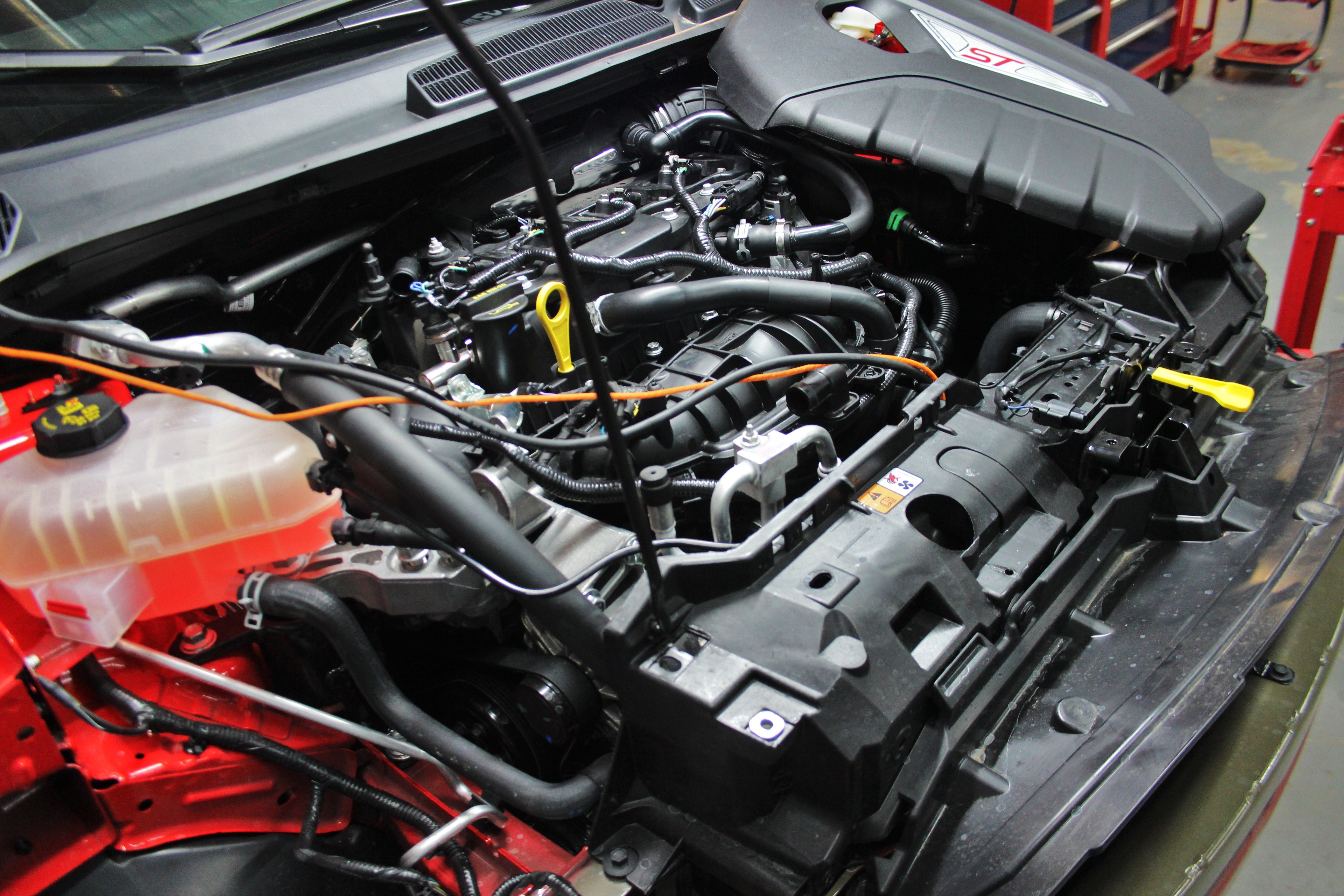
Don't Let Oil Temps Stop the Fiesta! Mishimoto Oil Cooler R&D, Part 2: Product Testing and Data Crunch
Interested in purchasing this awesome oil cooler system? Check out our product page for more details!
Mishimoto Ford Fiesta ST Oil Cooler Kit
Testing time! It's always fun to see the results when you make changes to your vehicle, whether bolting on a new wheel and tire combo, or installing a new set of dampers. In this case, we are expecting our Fiesta ST oil cooler setup to drop fluid temperatures by a substantial margin during our on-road testing.
Testing Setup and Conditions
Testing the stock Fiesta ST oil cooler is relatively simple. Only one temperature and pressure will need to be monitored, so we can utilize our sandwich plate sensor adapter shown below.
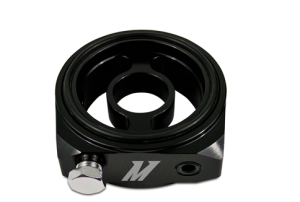
Mishimoto oil sensor adapter sandwich plate
To collect data with the stock Ford Fiesta oil cooler, we installed this plate along with one of our temperature sensors and one of our fluid pressure sensors. These would provide a baseline for oil temperatures produced with the stock liquid-to-liquid heat exchanger.
Testing the Mishimoto Fiesta ST oil cooler system would be a bit different. We decided to experiment with retaining the stock heat exchanger or removing it. We knew this would make an impact on fluid warm-up, but we were unsure of the impact on temperatures at speed. Would the stock Fiesta oil cooler inhibit or improve cooling performance when used in conjunction with our liquid-to-air unit? We will know very soon!
Our testing rig for the liquid-to-air setup involves sensors spliced into the oil lines going to and coming from the heat exchanger. Check it out!
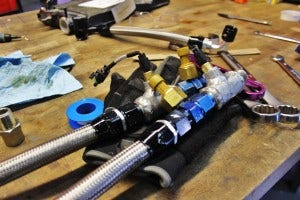
Oil temperature and pressure sensors installed in cooler line
These were then installed on the vehicle before hitting the road to collect our data for each Ford Fiesta oil cooler setup.
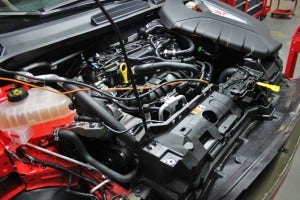
Oil temperature and pressure sensors installed on Fiesta
Now, just as a recap, we will be testing three Fiesta ST oil cooler setups on the road to evaluate differing cooling efficiencies.
- Stock liquid-to-liquid heat exchanger only
- Mishimoto oil cooler supplementing stock liquid-to-liquid heat exchanger
- Mishimoto oil cooler system only
We complete our Fiesta ST oil cooler testing in a similar fashion for most of the kits developed here at Mishimoto. This includes steady-state temperature collection data. Yes, track data would certainly help in supporting our product and providing data that would benefit customers. That said, the efficiencies we see during steady-state driving can be used as a basis for comparison to track driving. Since we own this ST, we may hit the track later for testing numerous developed products, including our Fiesta oil cooler. For now, though, this highway data will be sufficient to support the benefits of our Ford Fiesta oil cooler setup.
Testing Conditions
- Ambient temperature: 83° to 85°F (28.3 to 29.4°C)
- Vehicle: 2015 Ford Fiesta ST
- Modifications: stock
- Data equipment: AEM AQ-1 Data Logger
- Sensors: temperature and fluid pressure
- Driving conditions: 65 mph highway cruise for 10 minutes
- Sandwich plate: Mishimoto non-thermostatic
These conditions should provide a solid baseline for the performance of our Fiesta ST oil cooler kit. You will notice we are using our non-thermostatic oil sandwich plate for testing purposes. This will eliminate the variable of the thermostat as it restricts how low temperatures will drop.
Data Crunch!
The numbers are in! Check out the temperature plot from our three different Ford Fiesta oil cooler setups.
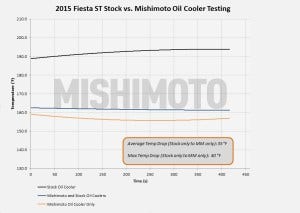
Oil temperature data from road testing the Fiesta ST oil cooler
Time to review.
Stock Liquid-to-Liquid Heat Exchanger
The stock Ford Fiesta oil cooler setup performed just fine on the highway. We saw temperatures start just below 190°F and climb to around 194°F by the end of the run. This is likely right around the temperature of the engine coolant, which is what we would expect with this setup. You can see that the plot slopes upward during the run.
Stable Temperature: 194°F
Mishimoto Oil Cooler Supplementing Stock Heat Exchanger
Here is where we begin to see the changes and advantages provided by a liquid-to-air heat exchanger. Temperatures at the start of the run hover in the neighborhood of 163°F. The plot then slopes downward over the duration of the data collection, eventually stabilizing around 161°F. This is a substantial drop of 33 degrees in fluid temperature during this driving condition. Keep in mind that these temperatures are a bit low for typical daily driving. Our final product will include an optional thermostatic sandwich plate that would peg this temperature at 185°F during equivalent conditions. We were simply testing efficiencies by eliminating all variables with our Fiesta ST oil cooler.
Stable Temperature: 161°F
Mishimoto Oil Cooler with Stock Heat Exchanger Removed
By removing the stock oil cooler we can reduce the impact of engine coolant temperatures on our oil cooler efficiency. With this setup installed, our plot begins at 159°F and quickly slopes downward. It peaks and then rises a few degrees, coming to a final stable temperature of 157°F. We saw 40°F maximum drops, with an average temperature drop of 35°F. As with the second Fiesta oil cooler setup, we will be recommending a thermostatic sandwich plate for this kit to retain temperatures within operating range specifications.
Stable Temperature: 157°F
Our next plot looks at fluid pressure. The addition of fluid volume presents changes in pressure, as does the differences in fluid temperatures. The hotter the oil, the thinner it will be, which will drop the pressure.
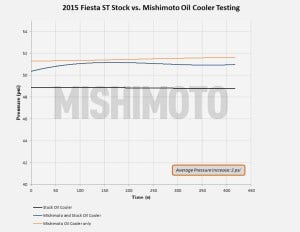
Oil pressure data from road testing the Ford Fiesta oil cooler
This data is pulled from the runs we used for temperature testing. The testing compiled with our Fiesta ST oil cooler system provides a 2 psi increase. How can that be so? It is likely that the cooler temperatures result in higher fluid viscosity, creating a slight increase in pressure. This is acceptable and will not cause any ill effects.
Great results!
Recap and Plans
We have seen positive results from the addition of our oil cooler system on this Fiesta. With this testing complete, we are ready to move forward with producing these kits. Our initial offering will be a 19-row unit. Based on our results here, we believe this will be necessary for track driving. Our 10-row unit may suffice, but we believe that our 19-row cooler will provide properly regulated temperatures in any track environment. For those concerned about fitment with large FMIC kits, we will have a solution for this soon. Our team is currently working on a large FMIC of our own that will be completely compatible with our oil cooler setup.
We will be offering a kit that eliminates the stock Ford Fiesta oil cooler. Fitting our sandwich plate on top of the stock cooler is quite a pain, as fitment was very tight. By removing this unit, we can also achieve better temperature drops.
Since we are removing the stock cooler, we needed to address the rubber coolant lines that run to and from this heat exchanger. We will include an aluminum splice connecter, which will mate the two lines and allow for proper coolant flow through the system. Our 3D-printed prototype is shown below!
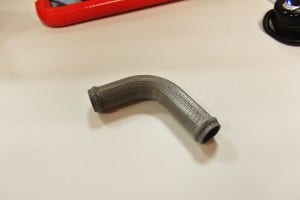
Delete fitting for stock Fiesta oil cooler
Sandwich Plate Options
We've discussed the two options (thermostatic and non-thermostatic) we have in terms of sandwich plate selection throughout this article series. One of the most common questions we get from these posts is in regards to the function of the plate and which plate is best. Check out some quick answers below!
What's The Difference?
Thermostatic: The thermostatic sandwich plate utilizes an internal thermostat to regulate fluid temperature. When the engine is cold and fluid is below thermostat temperature (185°F for this application), the sandwich plate restricts flow to the heat exchanger in order to allow the fluid to warm up quickly. Once up to temperature, the sandwich plate will regulate temperatures by restricting flow if fluid begins to cool to the activation temperature. This operation is similar to a coolant thermostat.
Non-Thermostatic: Unlike the thermostatic plate, this unit will not restrict flow based on temperature. When the vehicle is running, fluid will be routed to the heat exchanger regardless of temperature.
What Results Can I expect With Each?
Thermostatic: The thermostatic plate will warm the oil quickly and will also work to keep temperatures as close to the thermostat activation temperature as possible. During commuting or highway driving, the fluid temperature will likely hover right around activation temperature (185°F). During aggressive driving, temperatures may rise above activation temperature but the liquid-to-air heat exchanger will work to keep them as close to thermostat temperature (185°F) as possible.
Non-Thermostatic: Oil warmup will be a bit slower with this particular sandwich plate with our Fiesta St oil cooler. Expect to idle the car for a period of time and take it easy in terms of engine RPM during the first few miles of use. During normal driving conditions or highway cruising, the Fiesta will see temperatures in the 160°F range with the non-thermostatic plate. This is because the fluid is reaching the heat exchanger at all times and is actively being cooled even if it is not up to operating temperature. Remember, cold oil is just as harmful to your engine as hot oil. Keep this in mind when selecting a Ford Fiesta oil cooler system.
What Will Work Best For My Needs?
Thermostatic: For 95% of applications, we recommend our thermostatic option for the Mishimoto Ford Fiesta oil cooler. This is absolutely necessary if you drive your Fiesta daily. Like we noted above, you do not want to overcool the oil in your EcoBoost. Even track-specific models can utilize the thermostatic kit. The internal thermostat can be swapped out for two other optional temperatures (160°F or 200)°F for further fine tuning in your specific environment.
Non-Thermostatic: The non-thermostatic version should be reserved for track-specific models that will not see road use, or vehicles in very hot climates. We saw huge temperature drops with the Fiesta ST oil cooler and do not recommend this particular setup for commuter use.
Discounted Pre-Sale
As with some of our other Fiesta ST products, we want to launch a discounted pre-sale for those interested in picking up our Ford Fiesta oil cooler. Once we get a bit closer to the completion of these kits, we will release information about pricing and estimated shipping dates. Additionally, we will post a couple shots of our Ford Fiesta oil cooler final prototype brackets once they are complete!
Thanks for reading guys!
-John











